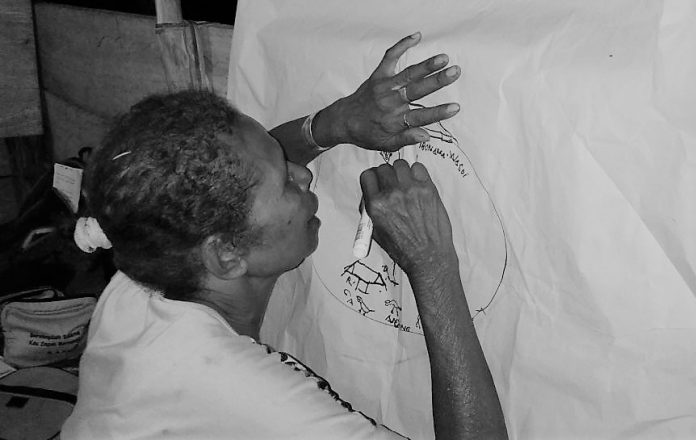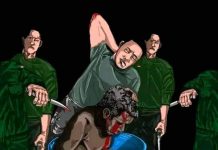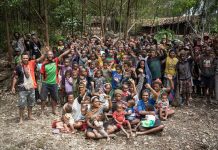By: Andre Barahamin)*
West Papua – consists of two provinces; West Papua and Papua – of Indonesia covers an area of forty two million hectares of which 85 percent is forest. According to Indonesia Statistical Agency (2015), there are more than 300 indigenous tribes with a total less than 2 millions population. West Papua is rich in both cultural, natural resources and conflicts.
Conflict in West Papua can be attributed into five main factors. First, is the persistent marginalization of and against West Papuan indigenous at the social, economic and political levels. Second is the failure of development in line with the aspiration from the indigenous communities and lack of opportunity to be included with the decision-making processes. Third is persistent State violence against West Papuans who are perceived as threat to nation-state integrity in regards with their demands for rights to self-determination. Fourth, is the political and historical path that has transformed West Papua into the subject of ongoing intense conflict. Fifth, is the natural resource exploitation at the hands of companies backed by the Indonesia state by ignoring the environmental, social and cultural impacts towards the local communities since its also violated the indigenous rights for prior consents.
There are three main natural resources exploitation in West Papua. First is the mining industry where it infamous face is PT. Freeport Indonesia located in Mimika regency. The mining include among others is mineral and natural gas extraction. Second is the timber logging activity where it concession areas covering more than nine and half millions hectares. Third is the palm oil plantation.
Palm oil plantation started it expansion into the region in 1982. It first plantation in Keerom, northeast of the island is the palm oil company run by the state-own enterprise. Palm oil massive expansion begun in the beginning of 1990s and rapidly growth from less than one million hectare in 2000 to reach two and half million hectares in 2015. In Papua, palm oil plantation areas mostly was converted from timber logging concession which began in early 1970s.
Timber logging targeting Merbau trees where most of which are to be sold out of Papua. When the forest cleared, the concession will be sold or handed over to the palm oil companies without obtaining consents from indigenous communities as the rights holder. Regardless that in several cases, the forest conversion from timber logging to be palm oil plantation obtained consents from the indigenous communities, women are mostly excluded from the decision making processes.
Yerisiam Gua tribe in Nabire regency of Papua province is one leading example on how the development and large-scale natural resource exploitation had brought different social and cultural problems, eco-disasters and law violation. Palm oil companies changed drastically production mode and social cultural relations within the community.
As the tribe who lives and occupied coastal areas and river banks, Yerisiam Gua inherited from their ancestors set of skills to use non-timber products as raw materials of different handy crafts for their basic needs. They made clothes, blankets, baskets, bags and many more. But deforestation and land use conversion into large-scale plantation has forced them to changed. Papuan indigenous people – particularly women – whom life depending on using and managing natural resources based on local knowledge and needs, suddenly has to adapts with new ways of using natural resources within the forest. They was threatened to be cast out if failed to follow up and adjusting themselves with new sets of knowledge, economic and working systems which are based on modern organizational values controlled by capital and state laws.
Losing forest and ancestral domain within a short period of time has led Papuan indigenous to changed their ways of life. It means that Papuan indigenous have to be completely different from what has been taught to them through generations. Papuan indigenous women in particular also facing and struggling with income loss which affected their abilities and qualities of foods.
In all those conflicts, Papuan indigenous women are suffers the most. They experienced and became the victims of changes mentioned above. Women are being ousted from the decision making regarding rights upon land, does not received compensation, victims of physical and psychological abuses within home and community. Added to the list, State and companies are both ignoring their duties to protect and to respect women’s rights.
The recent research conducted by PUSAKA Foundation found out that Papua indigenous women are facing with two main obstacles.
First, Papuan indigenous women facing with layers of prejudices. Being a woman considered as second class compared to man under the society influenced by patriarchal values. Women are believed to be weak, less smart and her roles limited to be mother – tool of reproduction. Beyond that, being women and attached with Papuan identity at the same time in Indonesian is another obstacle. Papuan indigenous women are constantly dealing with ongoing discrimination based on their physical appearances; i.e hair and skin color. Papuan women currently lives under the white beauty standards where it recognized by it bright color of skin and long straight hair. Added to those, being Papuan indigenous women who still lives and depends on forest are considered as ways of life which does not meet with the values of particular civilization. Indigenous women be regarded as backwards, primitives, and uneducated.
Second obstacle is where Papuan indigenous women facing with three main internal struggles within their household. First is to overcomes alcoholism of their men (husbands, sons and male relatives). Second, is to maintain tradition within their family by maintaining the continuing tradition of sago consumption and how to pass on the knowledge of processing various kinds of foods from sago to the younger generation. Third is the issue related with contraception. Papuan indigenous women are targeted as one who need to shoulder the responsibility for having children more than two as it advocated by government health officers and program campaigned by the state.
Regardless the fact that in State level, Indonesia have the policy against all forms of discrimination against women. National Action Plan clearly states to prevent and to protect women in conflict area. Papua provincial governance has also issued Local Regulation No. 8, Year 2013 where it specifically addressing victims of domestic violence as well as opening and giving women access to justice. Still, one can easily found that women are facing violence and discrimination.
This is the reason why enhancing women’s initiatives is so urgent. Capacity building which not limited to shaping women’s knowledge regarding their rights, but also to strengthen the abilities to identify self-potent, community potent, and natural resource potent around them that can be manage independently, collectively and sustainably. These abilities will shaping their analysis to overcome the obstacles that are holding women’s down and limiting their role, participation and contribution to the community in seeking to fulfill their rights.
)* The author is an anthropologist and works as researcher at International Institute of Research and Education (IIRE)






